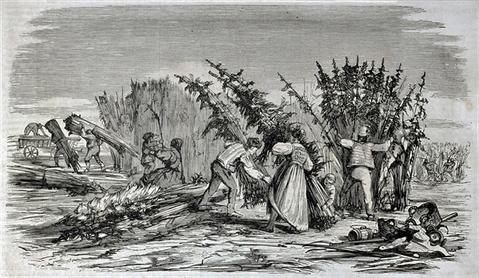With all the buzz about CBD and hemp, you’d be excused for thinking that cannabis cultivation is the newest trend in American agriculture. While it’s certainly enjoying its moment in the spotlight, nothing could be further from the truth, as hemp (the name for cannabis missing the psychoactive compound THC, found in marijuana) has been one of humanity’s most enduring and productive crops for the last 12,000 years.
…Hemp, it just so happens, is an extremely effective and profitable crop when inserted into a rotation.
Used for centuries to produce everything from textiles to money, food to sails (the word canvas is derived from cannabis), hemp was once considered so vital to our country’s economy that Colonial Americans were legally required to grow it, and Presidents Washington and Jefferson were enthusiastic Cannabis growers. Crop rotation is another subject with deep roots in human agriculture. Early farmers realized that annually alternating the crops planted in a field increased both the soil fertility of the field and its crop yield. This early discovery has benefited agriculture for millennia, and modern science only corroborates our ancestors’ agricultural wisdom. Due to the varied give-and-take of soil nutrients for different plants’ nutritional needs, the breaking of cycles of pestilence and disease, and improved soil structure and biomass due to diverse rooting systems, crop rotation remains a natural and effective tool for improving soil, increasing yield, and supporting sustainability in agriculture.

The plant’s helpful nutritional needs return nutrients to the soil, a long, drought-tolerant taproot increases soil biomass, loosens compacted soil, and helps prevent erosion, and a dense canopy works as a natural herbicide. Hemp has little need for pesticides, is good for the soil, and grows like a weed – with good resilience to adverse weather conditions. Add to this the high profitability of the harvest, and adding hemp to a rotation cycle is clearly advantageous for the land and wallet both.
First off, hemp reconditions the soil by adding nutrients like nitrates and potassium, that will increase the fertility and yield of the field. In a controlled study, wheat planted in a field the year after hemp showed a significant increase in yields. Hemp reconditions the soil, but it does have a large nitrogen uptake, and so does best when rotated with a nitrogen-fixing crop like alfalfa or legumes.
Another important feature of hemp that makes it a good rotation crop is its strong root-ball and long taproot. In addition to providing a good anchor for the plant, the long taproot can reach over 6 feet in depth. This allows the plant to search for water tables below what many plants can use, and as a result the plant is fairly drought-tolerant – it’s even grown without irrigation in the fields of its traditional Mediterranean habitat. The taproot not only plumbs the depths of the soi in search of water, it also digs deep into the soil for nutrients, bringing those life-giving molecules closer to the surface, where subsequent plants may benefit from them.
In addition to accessing underground water tables and bringing nutrients up from the deep soil, the taproot is beneficial to the field because it aerates and loosens compacted soil and increases biomass. Studies have shown evidence of high root biomass after a hemp harvest. This biomass accumulates in soil zones were mineralization is limited, and stores carbon, contributing positively to a sustainable cropping system.
Yet another trait recommending hemp as a rotation crop is its dense canopy cover. The serrated leaves form a broad canopy that chokes out other plants, leaving what may have been a field with perennial weed issues virtually weed free – without the use of herbicides.
Crop rotation is a sustainable way to keep fields healthy with improved soil fertility, structure, and biomass, and break pestilence and disease cycles – all without using expensive and/or toxic additives, pesticides, or herbicides. Hemp is an easy to grow weed with little need for pesticides and a resilience to adverse weather conditions. While it may seem like an obvious contender to act as a rotation crop on the surface, it is also a wonderful choice agriculturally. Hemp has nutritional needs that counterbalance many major crops, deep taproots that bring up nutrients and water from deep below the fields’ surface, aerate soil and improve its structure, and add biomass. Given its current price point and growing demand, ease of growth, high yield per acre, and sustainability, Hemp just might be the perfect rotation crop.
